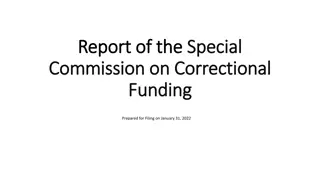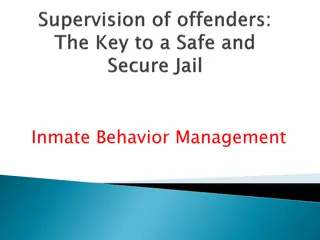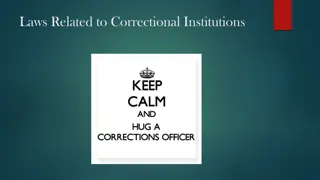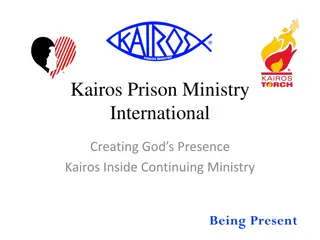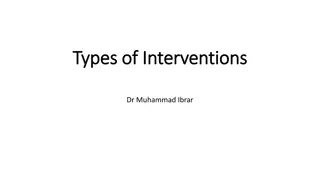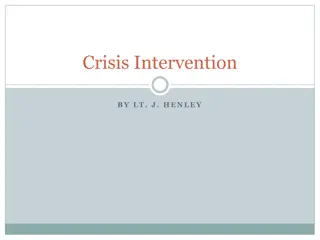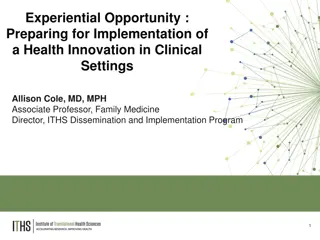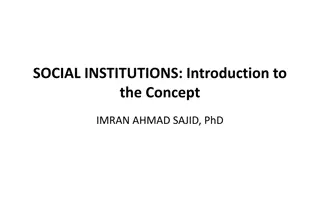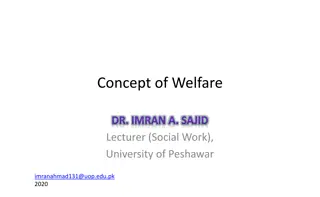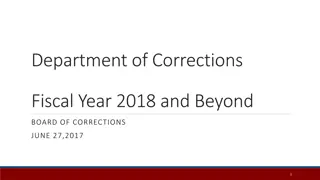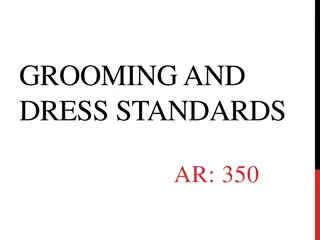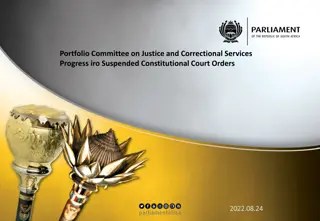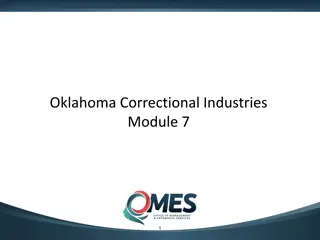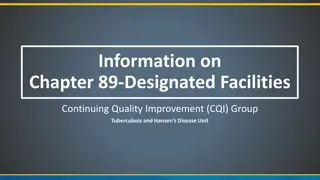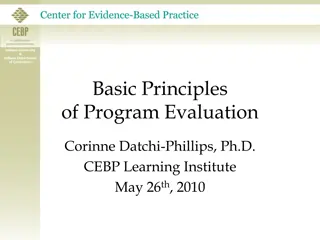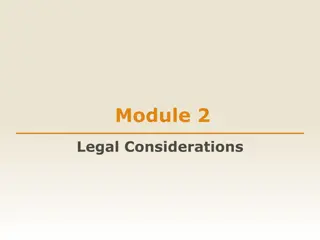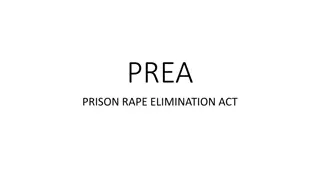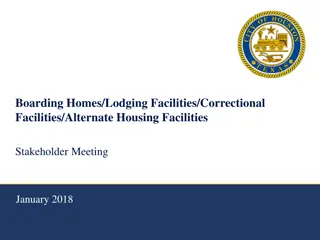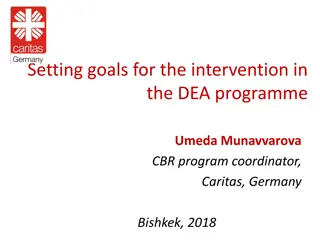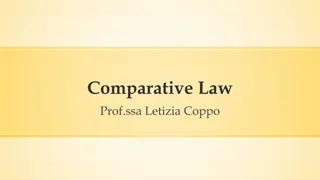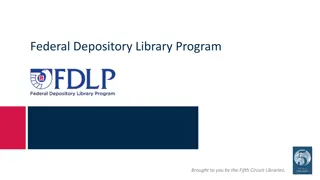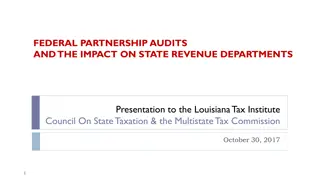Implementation of New Structured Intervention Unit Model in Federal Correctional Institutions
In November 2019, the Corrections and Conditional Release Act was amended to introduce a new Structured Intervention Unit (SIU) model, aiming to replace administrative and disciplinary segregation in federal correctional institutions. The SIU model emphasizes targeted interventions and programs to support inmates' safe return to mainstream populations. Despite challenges posed by COVID-19, the government remains committed to implementing this model effectively. The SIU system is designed to comply with Canadian law and international standards, providing inmates with opportunities for daily outdoor time and human interaction, access to programs, legal aid services, and health care monitoring.
- Federal correctional institutions
- Structured Intervention Unit
- Inmate rehabilitation
- Legal aid services
- Human rights
Download Presentation

Please find below an Image/Link to download the presentation.
The content on the website is provided AS IS for your information and personal use only. It may not be sold, licensed, or shared on other websites without obtaining consent from the author. Download presentation by click this link. If you encounter any issues during the download, it is possible that the publisher has removed the file from their server.
E N D
Presentation Transcript
Government responsetabled Response by the Minister of Public Safety and Emergency Preparedness Signed by (Minister or Parliamentary Secretary): JO L LIGHTBOUND, M.P. In November 2019, the Corrections and Conditional Release Act (CCRA) was amended to implement a new Structured Intervention Unit (SIU) model and abolish the use of administrative and disciplinary segregation in all federal correctional institutions. This new model is fundamentally different1from the previous model and constitutes a historic transformation of the federal correctional system. SIUs are meant as a temporary measures2and are intended to assist inmates and provide them with the opportunity to engage in targeted interventions and programs to support their safe return to a mainstream inmate population as quickly as possible. Although COVID-19 has created unique challenges throughout the federal correctional system, including SIUs,3the Government and the Correctional Service of Canada (CSC) are strongly committed to the successful implementation of this new model, both during and after the pandemic. Under the law, inmates in an SIU must be provided with the opportunity to spend a minimum of four hours a day outside of their cell, and two hours of meaningful human contact through 1There is little indication this model is fundamentally different from administrative segregation. The February report from Dr. Doob and Dr. Sprott found that 10% of prisoners qualify as beingtortured. Minister of Public Safety Bill Blair accepted this finding before the House of Commons Standing Committee on Public Safety. Former Minister of Public Safety, Ralph Goodale, conceded that the physical infrastructure of Structured Intervention Units are virtually indistinguishable from segregation units. Minister Goodale maintained that the change was still substantive: What makes segregation segregationis not the physical cell; it is the lack of human contact. It is the isolation. Yet, 79% of prisoners in an SIU did not get their full four hours out of their cell at least half the days of their stay. This is not a substantive change. 2To our knowledge, the longest a prisoner has spent in an SIU has been 454 days. The median length of time spent inan SIU in the Ontarioregion as of March 31, 2021 was 36 days. 3With MP Lightbound inattendance, Dr. Doob & Dr. Sprott noted before the Standing Committee on Public Safety that Covid was not the cause of the problems in the SIUs. These problems persisted before Covid as well. Indeed, Dr. Doob and Dr. Sprott dedicated an entire paper to the topic. 1
interaction with others.4In addition, inmates in an SIU have access to targeted programs and interventions. Furthermore, all inmates, including those placed in SIUs, have reasonable access to counsel and to the courts and are provided with information regarding the availability of legal aid services,5upon request. The SIU model responds to obligations under Canadian law6. Many safeguards specified in Canada s legislation were guided by international sources, such as the Mandela Rules7. These include the requirement for enhanced health care monitoring and empowering health care practitioners to make recommendations on an inmate s conditions of confinement.8The SIU system was purpose-built to monitor and minimize situations where inmates are spending too 4As mentioned, while we do not have records of what programs had been offered to SIU prisoners or why they might have been declined, the Doob/Sprott evidence shows 79% of prisoners in an SIU did not get their full four hours out of their cell at least half the days of their stay. 56% of SIU stays fail to get 2 hours outside of their cell for meaningful human contact. 5At Kent Institute in BC, a legal aid clinic was shut down by prison management. Three prisoners submitted national-level grievances in March 2020 regarding the cancellation of the legal clinic, but no response to these grievances has been received. Two of the three advised that they have not even received a confirmation of receipt of the grievance. Prisoners in the SIU regularly report that they were not told of their legal rights upon admission. Four days after the opening of Kent s SIU, Kent staff informed Prisoners Legal Service, in British Columbia, that they would no longer give prisoners messages to call their legal representatives. Kent administration also refuse to tell legal counsel at Prisoners Legal Service the date and time of the SIU review hearing. At John Howard Canada, we repeatedly try to connect with SIU prisoners, but remain unable to do so. 6Insofar as prisoners in SIUs are held in solitary confinement as defined by the Mandela Rules beyond 15 consecutive days (195 such prisoners identified by the Doob/Sprott data) or are not provided with effective, earlyindependent reviews of their placements in such conditions, the Charter protections recognized in the BC and Ontario Court of Appeal decisions relating to administrative segregation are being violatedin contraventionof Canadian Law. 7In line with the Nelson Mandela rules, 28% of SIU stays are classified as solitary confinement and 10% are classified as torture. According to Rule 43 and Rule 44 of the Mandela Rules,prolonged solitary confinement should not be used for a period of 15 days straight or more. As mentioned in Note 2, one prisoner has spent 454 days straight in an SIU. Further, Mandela Rule 45(1) states that prisoners with mental disabilities, or conditions that would be exacerbated by solitary confinement, not be subjected to solitary confinement. CSC violates this rule by placingprisoners with mental health needs in solitary confinement. 8Dr. Doob, Dr. Sprott, and Dr. Iftene found that there is no significant relationship between whether a prisoner in an SIU is assessed as having mental health needs and whether the oversight reviews triggered when their stay is longer than 60 days helpsCSC to determine that the individual would be more appropriatelyplaced elsewhere. 2
much time in a cell, as well as provide strong safeguards such as enhanced health services and external decision-making.9 With respect to the Optional Protocol to the Convention against Torture, work is ongoing on this complex and important treaty. Federal, provincial and territorial government officials have been carefully assessing options for implementation, by studying the approaches taken in various other countries that have already implemented the Optional Protocol. To date, the consideration process has involved two rounds of consultations led by Justice Canada, in 2016 and 2017, with Provincial and Territorial governments, and also within the Government of Canada. While significant progress has been made,10there is a range of policy and implementation issues and additional consultations that remain to be undertaken in the future. There were 181 inmates in Structured Intervention Units (SIUs) on May 13, 2021, which roughly represents 1.5% of federal inmates in Canada.11 SIUs are in place at 15 of our 43 institutions. Inmates can only be transferred to an SIU if they meet one of the three criteria in section 34 (1) of the Corrections and Conditional Release Act and there are no other reasonable alternatives to placement in a SIU. SIUs are meant as a temporary measure12to help inmates adopt more positive behaviours that keep the institution safe and secure. 9In practice, the SIU system has admitted data integrity problems and is failingto prevent about 10% of those placed in them fromexperiencingprohibited, prolonged solitary confinement: Feb 2021 Doob/Sprott Report. The more recent Doob/Sprott/Iftene Report confirms that the independent-external decision-maker provisions are not adequate to protect prisoners from long confinement in SIUs. 10What significant progress'' has been made? After nearly no political traction, the Canada OPCAT Project closed its doors in April 2021. Canada OPCAT noted that, after years of advocacy, no progress had been made on this now dormant policy file. For context, Afghanistan, South Sudan and most of our allies have already acceded to or ratified this treaty. Dr. Doob himself stated that he found it disturbing to have to calculatea torturerate within Canadian institutions. 11Black and Indigenous prisoners spend longer in SIUs. Black prisoners represent 29% of SIU stays that are 62-360 days and Indigenous prisoners represent 20% of SIU staysthat length. 12See note 2 3
Institutional security is critical, and inmates who are transferred to an ISU pose exceptional and extreme challenges to institutional security.13 Before transferring an inmate to a SIU, every possible reasonable alternative is explored.14 Alternatives include, but are not limited to, a transfer to a different unit or range with the institution, involvement of the Inmate Committee or the range representative, mediation or conflict resolution, transfer to another institution or a regional treatment centre, involvement of staff who have influence over the inmate, such as an Elder, Chaplain or Indigenous Liaison Officer. It is important to note that support for inmates is not a one-size fits all approach and involves some difficult and complex situations. For example, inmates with complex health care needs often require interdisciplinary teams to work with them. While some cases can resolve quickly through informal resolution, others take time, and require ongoing care and steady work to help the inmates safely reintegrate within mainstream population.15 Health Services Within 24 hours of their transfer to an SIU, an inmate is referred to Health Services for an assessment of their health, including mental health, which is repeated every 14 days. 13SOLITARY BY ANOTHER NAME: Prisoners in SIUs are often there because of behaviours caused by mental health difficulties (i.e. symptoms of PTSD include being on-edge due to feelings that other prisoners or correctionsofficers could attackthem at any moment). Many people in SIUs are those with untreated mental health difficulties,and they are more likely to end up in SIUs and spend more time in the SIU than if their mental needs were addressed. 14SOLITARY BY ANOTHER NAME: A prisoner at Kent Institution SIU who is certified under the Mental Health Act was kept in the SIU for months after being transferred from a CSC treatment centre. At a CSC stakeholder meeting, the issue was raised that prisoners lack real alternatives to SIUs other than return to maximum security. Such alternatives could be transfer to a lower security level, healing lodges, and treatment centres. 15SOLITARY BY ANOTHER NAME: Long-term social isolation can lead to social withdrawal. A prisoner in the SIU was scared to leave his cell and be around other prisoners. Security at the institution found that this prisoner s fears that other prisoners were trying to kill him were unfounded. However, failed to consider he might be experiencing paranoia. 4
This is followed by a mental health assessment within 28 days of being transferred to an SIU.16 If, at any time, a registered health care professional believes that, due to health reasons, an inmate should not remain in the SIU or that the inmate s conditions of confinement should be altered, the registered health care professional will make a recommendation in writing to the institutional head. The institutional head must make a decision as soon as practicable. If the institutional head does not implement the recommendation, the case is referred to the Health Committee, which is chaired by the Assistant Commissioner of Health Services. External Oversight Mechanism Through the establishment of an external oversight mechanism, the CCRAprovides a critical safeguard. Although CSC maintains its own internal protocols and review processes for SIU transfers, Independent External Decision Makers (IEDMs) across the country operate at arms- length from CSC to provide decision-making oversight of an inmate s conditions and duration of confinement in a SIU.17IEDMs monitor and review inmate cases on an ongoing basis and provide recommendations and decisions to CSC. An IEDM review occurs under the following conditions: 16SOLITARY BY ANOTHER NAME The individual mentioned in note 9 requested a psychological assessment multiple times but did not receive one. He continued to spend months in the SIU, waiting for a transfer to another region. Another prisoner at Kent Institution SIU had not seen anyone from mental health services since he arrived. He is borderline schizophrenic and had submitted a request to see someone from mental health services but no one came to see him. Some prisonersalso reported that when health care staff do their dailyrounds, they are escorted by securitystaff, which makes it intimidating and also violatesdoctor-patient confidentiality. 17Do Independent External Decision Makers Ensure that An Inmate's Confinement in a Structured Intervention Unit Is to End as Soon as Possible ? CSC has tried to emphasize two independent oversight bodies (IAP and IEDM). IAP did not exist as of May 9 2021 and even when it was operational, it concluded that it could not operate, as CSC refused to comply withinformation requests. IEDM decisions to remove an individual from the SIU take a significant period of time (around three months) which likely does not reduce the length of stays for many prisoners. There is also a significant lack of understanding regarding IEDM decision-making. In this study, Dr. Doob, Dr. Sprott, and Dr. Iftene were not only unable to examine in detail how the IEDM process works, but also concluded that there is no one who appears to be doing it. There is an extreme lack of oversight and transparency regarding IEDM decision-making. 5
IEDMs review an inmate's case under four specific circumstances, as defined in the CCRAand regulations: Length of time An inmate has been confined in an ISU for 90 consecutive days (and every subsequent 60 days). Conditions of Confinement An inmate has not received a minimum of four hours per day out of their cell, or at least two hours of interaction with others, for five consecutive days, or 15 cumulative days in a 30-day period.18 If the IEDM finds that CSC has taken all reasonable steps in the above determination, but in the last 10 consecutive days the inmate has not received these opportunities, the IEDM must determine whether the inmate should remain in the SIU. Health care If the Health Committee19determines that an inmate s conditions of confinement in the structured intervention unit should not be altered in accordance with a recommendation of a registered health care professional, the IEDM must determine whether the inmate should remain in the unit or whether the inmate s conditions of confinement in the unit should be altered. IEDMs have binding authority to determine that an inmate should not remain in an SIU20, or in some circumstances, order that the conditions of confinement in the SIU to be altered. Each 1815 days without an opportunity for meaningful human contact and without four hours outside of a cell is a blatant violation of the UN s Nelson Mandela Rules 43 and 44. It alsoviolates section36 1 (a) and section 36 1 (b) of the Corrections and Conditional Release Act. 19Health professionals are to act in the best interest of the patient. The Health Committee is contracted by CSC. As per Rule 25 (2) of the Nelson Mandela Rules, health care professionals must have full clinical independence so as to ensure the well-being of the patient remains top of mind. As the example of Dr. John Farley shows, health professionals on contract with CSC may face obstacles to speaking freely in the midst of healthcare concerns. 20The May Doob/Sprott/Iftene report found that those "ordered" to be removed from an SIU were actually not released any faster than those who were told to stay in. 6
IEDM brings specific expertise to their role. They are comprised of lawyers, professors, and researchers specializing in the fields of criminal justice, mental health, vulnerable populations, human rights, and administrative law.21Since the beginning of SIU operations, IEDMs have done significant work, rendering more than 1,400 binding decisions.22 In addition to the important role played by IEDMs, the Office of the Correctional Investigator maintains broad oversight of federal corrections and is empowered by the CCRAto investigate the operations and decisions of CSC,23including those related to SIUs. Further, several external reports prepared by academics have provided valuable insight into the operation of SIUs.24 Summary Since the implementation of the Structured Intervention Units on November 30, 2019, there are significantly fewer inmates in SIUs than in the former model.25This shows that many efforts are being made to proactively manage inmates within a mainstream population and use of SIUs as a last resort. Five years ago, in March 2016 there were 454 inmates in administrative segregation compared to 182 inmates in SIUs across the country on May 5, 2021. During 2015-16, there were 6,788 admissions to administrative segregation whereas the total number of authorizations for transfer to an SIU that started betweenApril 1, 2020 and March 31, 2021 was 2,267.26 21The identities of the IEDMs have never been disclosed. Therefore, there is no way to ascertainthe veracity of this statement. According to a recent ATIP, CSC does not know the identity of their IEDMs. This is puzzlingas they receive and, allegedlyimplement,their decisions. 22It is incrediblyconcerning that the IEDMs were required to render 1,400 decisions in two years simply to ensure CSC s legislativecompliance. 23The Correctional Investigator has noted blatant evidence of non-compliance. He has provided recommendations, which, CSC has repeatedly rebuffed. Dr Zinger notes There s noncompliance, inconsistency [in the law],and I think at one point you ve got to concede defeat and bring in new legislation that would be more helpful. He noted his office was not consulted on Bill C-83 and the subsequent scheme which is puzzling at best. 24Drs Doob, Sprott and Iftene have noted torture is occurring inside SIUs. Despite repeated outcry from esteemed academics,no measures have been taken in response. 25As CSC has repeatedly pointed out, the two systems were not meant to be comparable in any way. Why a comparison is beingmade between the two systems to demonstrate the news system s success is therefore quite unclear. 26Again, it is unclear why a comparison is being made between a system which is alleged to be fundamentally different than solitary confinement. 7
We recognizes that there are cases where inmates in SIUs are not taking advantage of opportunities to leave their cell.27We are working to provide more options for inmates to engage in time out of cell and opportunities for meaningful human contact. 28We have also been taking 29 actions to address some30of the trends and regional differences identified through our data and that of external academics and stakeholders. With respect to data, CSC also has a dedicated project team that is currently working to improve the integrity, timeliness and quality of data available.31In addition, CSC has gathered best practices and is sharing them across the country.32This helps to target common challenges to support frontline operations. Regular meetings and town halls take place with regions to build on lessons learned and determine additional improvements needed. 27Drs Doob & Sprott have repeatedly emphasized that 89% of SIU prisoners pursue opportunities for time outside of the cell (on 50% or more of their days in the SIU). The questionremains whether the remaining 11% of individuals are concerned for their safety when offered these opportunities. Again, as stakeholder groups cannot access these individuals, we cannot make any determination on this matter. 28John Howard Canada has repeatedly offered to provide meaningful human contact to prisoners inside SIUs. In the midst of the pandemic, we repeatedly offered to provide meaningful human contact by telephone so as to keep everyone safe. Not a single prisoner has been able to contact us. Despite this, on multiple occasions, CSC has publicly thanked John Howard Canada and other stakeholder groups, for engaging with SIU prisoners. As noted above, we have been unable to engage with even a single SIU prisoner. 29What action has been taken? To stakeholders knowledge, no action whatsoever has been taken. 30Which trends? To stakeholders knowledge, no action whatsoever has been taken. 31CSC refused to release data to federally-appointed experts. Minister Blair then ordered CSC to release the data. Following this, data integrity issues emerged. Based on documents provided to the Parliamentary Standing Committee on Public Safety, CSC was aware of data integrity issues as early as January 2020. These data integrityissues persist. As a CSC presentation from November 2020, notes in bold [an SIU] evaluationcan only be completed once data integrity issues are resolved. (page 23). Current data integrity issues in OMS prevents reporting on key short-term outcome indicators (quantitative results. (page 27). CSC s author remarks At thistime, it is unknown if data are available. (page 25). 32 80% of inmates who spent over a month in an SIU in B.C. received lessthan a quarter of the legally required time out of their cell. 8
As we continue to learn and make adjustments, CSC remains steadfast in its commitment to ensure the success of this new correctional model while we fulfill our mandate of ensuring the safe rehabilitation of federal inmates in Canada.33 With respect to body cameras, CSC is not currently exploring their use at this time.34 History Open for signature December 16, 2020, at 2:07 p.m. (EDT) Closed for signature April15, 2021,at 2:07 p.m. (EDT) Presented to the House of Commons Randall Garrison (Esquimalt Saanich Sooke) May 12, 2021 (Petition No. 432-00953) Government response tabled June 23, 202135 33In her first meeting with Stakeholders on June 17-18, 2021, Commissioner Kellynoted that 26% of SIU prisoners will be released on statutory release within 6 months of serving time in an SIU. To many of us in the Correctional Law community, the choice of the word safe to describe this practice is concerning. 34After seven years, a video recently emerged of seven CSC guards assaulting a Black prisoner without provocation. According to the media, Commissioner Kelly determined no corrective action was warranted. Our concern is not that CSC has explored the use of body cameras. Our concern is that CSC has not explored the use of body cameras. The Senate Committee on Human Rights has found that racism, violence and discrimination are rampant throughout Canadian Prisons. In this context, CSC should be exploring the use of body cameras in prisons. Hence the purpose of the call in Petition E-3023. 35The House rose on June 23, 2021. Our petition, drawing attention to human rights abuses and torture was responded to at 6:25 pm on the day the house rose, inhibiting substantive responses. 9


